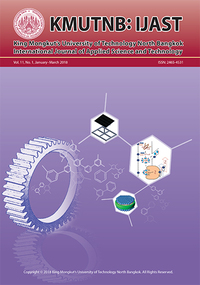pH-Responsive Styrene Maleic Anhydride with Improved Surface Activity
Main Article Content
Abstract
pH-Responsive poly(styrene-alt-maleic anhydride) were synthesized and modified to improve their surface activity for transmembrane protein extraction. Different samples were synthesized by single-step solution polymerization using peroxy radical initiator, prior to esterification. The half esterified samples (ePSMA) became weaker polyelectrolytes with reduced acid dissociation constant (ka). In the low compression region (>23 cm2), it showed reduced surface pressures, implying weakened lateral electrostatic repulsion. It could also decrease water surface tension to 40 mN/m, beyond that of the unmodified one. The method has proved to be useful for a design of workable pH-switchable systems for a wider context of extraction technology.
Article Details
How to Cite
Punyamoonwongsa, P., Tangsongcharoen, W., Phoungtawee, P., & Tighe, B. (2018). pH-Responsive Styrene Maleic Anhydride with Improved Surface Activity. Applied Science and Engineering Progress, 11(1), 45–51. retrieved from https://ph02.tci-thaijo.org/index.php/ijast/article/view/211389
Issue
Section
Research Articles
References
[1] S. Seth, D. Chakravorty, V. K. Dubey, and S. Patra, “An insight into plant lipase researchchallenges encountered,” Protein Expression and Purification, vol. 95, pp. 13–21, Mar. 2014.
[2] D. Lichtenberg, H. Ahyayauch, and F. M. Goñi, “The mechanism of detergent solubilization of lipid bilayers,” Biophysic Journal, vol. 102, no. 2, pp. 289–299, Jul. 2013.
[3] S. Kalipatnapu and A. Chattopadhyay, “Membrane protein solubilization: Recent advances and challenges in solubilization of serotonin1A receptors,” International Union of Biochemistry and Molecular Biology Life, vol. 57, no. 7, pp. 505–512, Jul. 2005.
[4] A. R. Long, C. C. O'Brien, K. Malhotra, C. T. Schwall, A. D. Albert, A. Watts, and N. N. Alder, “A detergent-free strategy for the reconstitution of active enzyme complexes from native biological membranes into nanoscale discs,” BMC Biotechnology, vol. 13, no. 41, pp. 1–10, May. 2013.
[5] J. M. Dörr, M. C. Koorengevel, M. Schäfer, A. V. Prokofyev, S. Scheidelaar, E. A. W. van der Cruijsen, T. R. Dafforn, M. Baldus, and J. A. Killian, “Detergent-free isolation, characterization, and functional reconstitution of a tetrameric K+ channel: The power of native nanodiscs,” Proceedings of the National Academy of Sciences, vol. 111, pp. 18607–18612, Dec. 2014.
[6] M. Tanaka, A. Hosotani, Y. Tachibana, M. Nakano, K. Iwasaki, T. Kawakami, and T. Mukai, “Preparation and characterization of reconstituted lipid–synthetic polymer discoidal particles,” Langmuir, vol. 31, no. 46, pp. 12791–12726, Nov. 2015.
[7] J. Jeong, B. Y. Seop, and Y. S. Lee, “Synthesis and modification of some heterocyclic compound,” Reactive and Functional Polymers, vol. 50, pp. 257, 2002.
[8] A. P. Girard-Egrot and L. J. Blum, “Langmuirblodgett technique for synthesis of biomimetic lipid membranes,” in Nanobiotechnology of Biomimetic Membranes, D.K. Martin Ed. Springer US, pp. 23–74, Dec. 2007.
[9] G. Garnier, G. Garnier, M. D.-S. R. Vyhnalkova, T. G. M. van de Ven, and J.-F. Revol, “Assoication in solution and adsorption at an air-water interface of alternating copolymers of maleic anhydride and styrene,” Langmuir, vol. 16, pp. 3757–3763, Mar. 2000.
[10] V. Saez-Martinez, P. Punyamoonwongsa, and B. J. Tighe, “Polymer-lipid interactions: Biomimetic self-assembly behaviour and surface properties of poly(styrene-alt-maleic acid) with diacylphosphatidylcholines,” Reactive and Functional Polymers, vol. 94, pp. 9–16, Sep. 2015.
[2] D. Lichtenberg, H. Ahyayauch, and F. M. Goñi, “The mechanism of detergent solubilization of lipid bilayers,” Biophysic Journal, vol. 102, no. 2, pp. 289–299, Jul. 2013.
[3] S. Kalipatnapu and A. Chattopadhyay, “Membrane protein solubilization: Recent advances and challenges in solubilization of serotonin1A receptors,” International Union of Biochemistry and Molecular Biology Life, vol. 57, no. 7, pp. 505–512, Jul. 2005.
[4] A. R. Long, C. C. O'Brien, K. Malhotra, C. T. Schwall, A. D. Albert, A. Watts, and N. N. Alder, “A detergent-free strategy for the reconstitution of active enzyme complexes from native biological membranes into nanoscale discs,” BMC Biotechnology, vol. 13, no. 41, pp. 1–10, May. 2013.
[5] J. M. Dörr, M. C. Koorengevel, M. Schäfer, A. V. Prokofyev, S. Scheidelaar, E. A. W. van der Cruijsen, T. R. Dafforn, M. Baldus, and J. A. Killian, “Detergent-free isolation, characterization, and functional reconstitution of a tetrameric K+ channel: The power of native nanodiscs,” Proceedings of the National Academy of Sciences, vol. 111, pp. 18607–18612, Dec. 2014.
[6] M. Tanaka, A. Hosotani, Y. Tachibana, M. Nakano, K. Iwasaki, T. Kawakami, and T. Mukai, “Preparation and characterization of reconstituted lipid–synthetic polymer discoidal particles,” Langmuir, vol. 31, no. 46, pp. 12791–12726, Nov. 2015.
[7] J. Jeong, B. Y. Seop, and Y. S. Lee, “Synthesis and modification of some heterocyclic compound,” Reactive and Functional Polymers, vol. 50, pp. 257, 2002.
[8] A. P. Girard-Egrot and L. J. Blum, “Langmuirblodgett technique for synthesis of biomimetic lipid membranes,” in Nanobiotechnology of Biomimetic Membranes, D.K. Martin Ed. Springer US, pp. 23–74, Dec. 2007.
[9] G. Garnier, G. Garnier, M. D.-S. R. Vyhnalkova, T. G. M. van de Ven, and J.-F. Revol, “Assoication in solution and adsorption at an air-water interface of alternating copolymers of maleic anhydride and styrene,” Langmuir, vol. 16, pp. 3757–3763, Mar. 2000.
[10] V. Saez-Martinez, P. Punyamoonwongsa, and B. J. Tighe, “Polymer-lipid interactions: Biomimetic self-assembly behaviour and surface properties of poly(styrene-alt-maleic acid) with diacylphosphatidylcholines,” Reactive and Functional Polymers, vol. 94, pp. 9–16, Sep. 2015.


